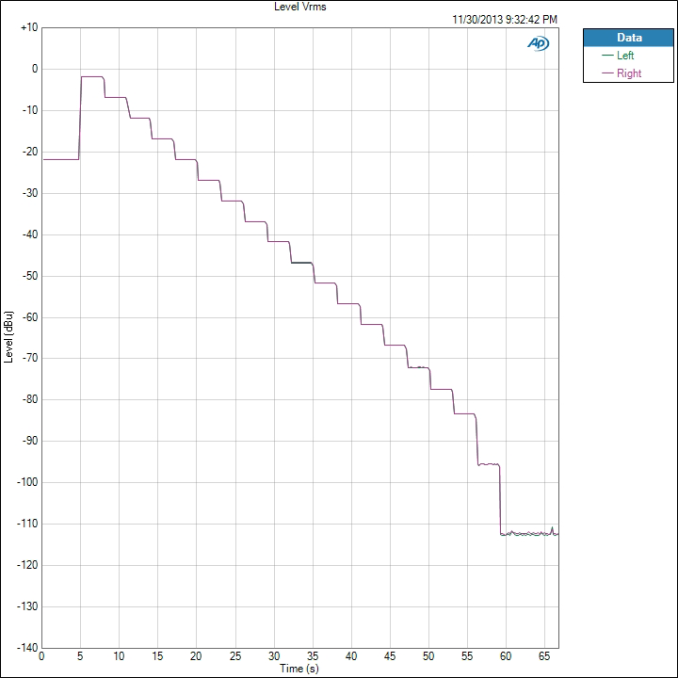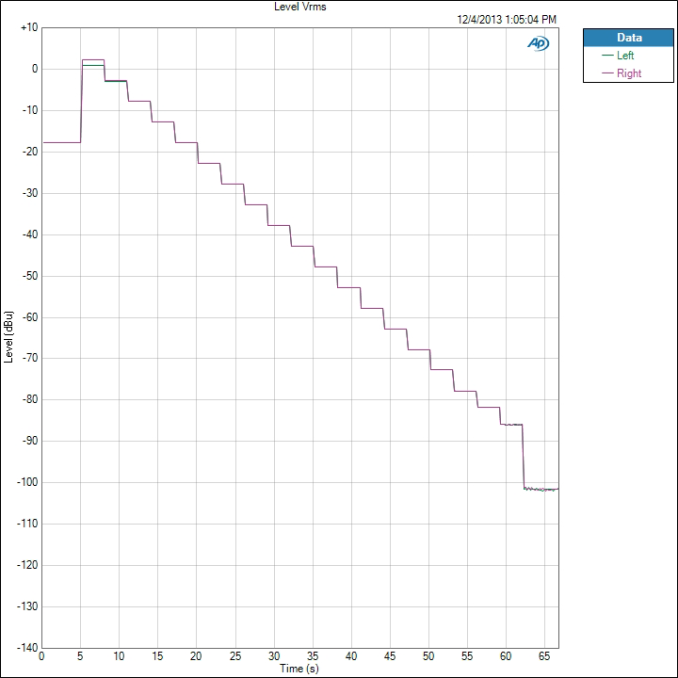Smartphone Audio Quality Testing
by Chris Heinonen on December 8, 2013 5:15 PM EST- Posted in
- Smartphones
- Audio
- Mobile
- Tablets
- Testing
Dynamic Range
The dynamic range of the phone indicates the difference between the loudest possible sound and the background noise. The more residual noise in the background, the lower the dynamic range. Phones with more powerful amplifier sections will typically produce a greater dynamic range. The residual noise level is often constant, so as the overall volume level increases the difference between the music and the noise increases as well.
The best performer here is the iPhone 5 again, with 92.214 dB of range. The worst is the Nexus 5 with only 89.332 dB. A difference of 3 dB is not something I would concern myself over. If we see a phone or tablet that drops down below 80 dB then I will start to show more concern.
Crosstalk
Crosstalk, like dynamic range, is just a number here. This is the measurement how much signal leaks from one channel into another. If an instrument should only be in the right ear, some of that signal will leak into the left ear, but we want that as low as possible. The results are expressed in -dB, or how much quieter one ear is than the intended ear.
On the Note 3 we see a wonderful crosstalk measurement of -117.2 dB so the sounds in one ear are -117 dB quieter in the other ear. This makes them impossible to hear. The worst is the iPhone 5, with only -75.624 dB of isolation.
Stepped Response
The stepped response uses a 1 kHz 0 dBFS tone but measures output level from maximum volume to minimum volume. We can see how large the volume steps are and how many there are. It doesn’t produce a number we can use, but it ties back into our other results. For a good example, we can look at the Note 3.
We see steps that are around -5 dBu each. The final level is muted and just the background noise of the device. Each step is clean and even but as we get lower and lower we see noise start to intrude. This is the background noise starting to become audible in the signal. The flatter the levels are, the quieter it will be. Now, let us look at the Nexus 5.
Notice at the very top how the right and left channels do not overlap. That is the clipping we talked about at the very beginning. It isn’t until the 4th volume setting that the level difference is down to nothing. Because of this, I would consider the top 3 volume settings of the Nexus 5 as ones that should be avoided. They each have enough THD+N introduced into them that it will sound poor, and one ear will be louder than the other.












188 Comments
View All Comments
ph00ny - Thursday, December 12, 2013 - link
i9100 had yamaha DAC and was dismissed by many as poor choice moving away from wolfson DAC which sounded especially great with voodoo sound. As for S3, US variants with Snapdragon did not come with Wolfson DACThe Von Matrices - Sunday, December 8, 2013 - link
I own an S3 and I hate that it's output has a bass boost profile similar to the HTC One with its "Beats" profile. It's probably great for earbuds but for any other listening device the bass is overdriven. If it just produced a flat output I would be completely happy with it.Impulses - Monday, December 9, 2013 - link
Can't it be turned off somewhere? HTC's Beats glorified EQ can be turned off and ignored entirely, well, except for the persistent notification that lets you know that it is indeed turned off (seriously).Samus - Monday, December 9, 2013 - link
A lot of custom roms try to circumvent Samsung audio layer with a combination of audio filters. Its pretty depressing...S3 owner here.speculatrix - Tuesday, December 10, 2013 - link
Xda devs is full of discussions about things like boeffla Kernel tweaks and hacks which expose more of the hardware controls of Wolfson DACs and thus allow customization of sound EQ.It does seem to be the case that you really do have to research a specific phone and all it's variants to be sure of getting the audio chain you want.
barry spock - Monday, December 9, 2013 - link
Excellent stuff. I hope you can do a showdown of the most popular phone models out there at the moment, including the iphone 5s.PrinceGaz - Monday, December 9, 2013 - link
I'd like to see iPod touch models added to the mix also, as whilst not actually a smartphone, it is in many ways very similar and music listening on it through the headphone jack is a major selling point of it. The thing is, as you don't need to hear it "ring" in a loud room, it has a much weaker internal speaker than any smartphone, so is the audio-amp driving the earphone socket as good as that of the iPhone, or have they saved money on it to hit the lower price point?Bansaku - Tuesday, December 10, 2013 - link
I too would like to see this as well. Especially between the 4th and 5th Gen. I swear the audio quality of my 4th Gen is superior to my 5th Gen. I also wonder the difference between the various models of iPhones.JoannWDean - Saturday, December 14, 2013 - link
my buddy's aunt earned 14958 dollar past week. she been working on the laptop and got a 510900 dollar home. All she did was get blessed and put into action the information leaked on this site... http://cpl.pw/OKeIJotipoo - Sunday, December 8, 2013 - link
This is perfect, I havn't read it all but I have an ancient Nexus S and it has horrendous headphone output. I've heard the next two Nexii weren't great in that either. Lots of hiss from all the radios, and even if there was no hiss there's just an odd EQ curve or something, it makes the bass muddy. I think the program Voodoo sound helped it but not completely. So audio output will be an important consideration in my next phone.